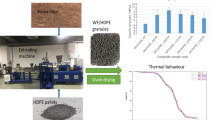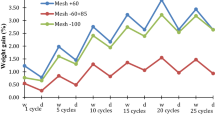Abstract
Plant fiber biocomposites have the potential of being thermal insulating materials with strong mechanical resistance. However, they are vulnerable to defects due to the incompatibility of the materials. In that prospect, this study focuses on the determination of thermal properties of wood particles reinforced HDPE composites (WPC) using experimental, theoretical, and computational modeling approaches. From the laser flash analysis in the experimental setup, the results show that the addition of 30 and 60 \(\text{wt\%}\) of wood particles leads to a reduction of 20 and 44% in thermal conductivity, respectively, as compared to the neat HDPE. This demonstrates the thermal insulation capabilities of the wood particles. The use of several theoretical models to determine the WPC’s effective thermal conductivity shows good consistency with the experimental results, with a maximum discrepancy error of 4%. However, a noticeable divergence is observed as the wood content increases. Further study on the effective properties is carried out using the pixel-based computational homogenization analysis. This computational method carries out finite element calculations on representative 2D images of the WPC. The computational results are also consistent with the experimental results, but similar divergence like the theoretical models is still observed. The divergence is suspected to originate from the presence of porosity in the experimental specimens. The percentage of porosity is estimated using theoretical models and is integrated into the computational homogenization technique by introducing another phase in a different color code. This leads to the convergence of computational and experimental results. The pixel-based homogenization method has shown great flexibility and is able to integrate defects like porosity to yield precise results of the effective thermal conductivity of WPC which can then be used in structural engineering analysis.













Similar content being viewed by others
Data availability
The raw/processed data required to reproduce these findings cannot be shared at this time due to technical or time limitations.
References
Agoua E, Allognon-Houessou E, Adjovi E, Togbedji B (2013) Thermal conductivity of composites made of wastes of wood and expanded polystyrene. Constr Build Mater 41:557–562. https://doi.org/10.1016/j.conbuildmat.2012.12.016
Ahmad Rasyid MF, Salim MS, Akil HM, Karger-Kocsis J, Ishak ZAM (2019) Non-woven flax fibre reinforced acrylic based polyester composites: the effect of sodium silicate on mechanical, flammability and acoustic properties. Express Polym Lett 13:553–564. https://doi.org/10.3144/expresspolymlett.2019.47
Alhijazi M, Zeeshan Q, Safaei B, Asmael M, Qin Z (2020a) Recent developments in palm fibers composites: a review. J Polym Environ 28:3029–3054. https://doi.org/10.1007/s10924-020-01842-4
Alhijazi M, Zeeshan Q, Qin Z, Safaei B, Asmael M (2020b) Finite element analysis of natural fibers composites: A review. Nanotechnol Rev 9(2020):853–875. https://doi.org/10.1515/ntrev-2020-0069
Annie Paul S, Boudenne A, Ibos L, Candau Y, Joseph K, Thomas S (2008) Effect of fiber loading and chemical treatments on thermophysical properties of banana fiber/polypropylene commingled composite materials. Compos Part Appl Sci Manuf 39:1582–1588. https://doi.org/10.1016/j.compositesa.2008.06.004
Asdrubali F, D’Alessandro F, Schiavoni S (2015) A review of unconventional sustainable building insulation materials. Sustain Mater Technol 4:1–17. https://doi.org/10.1016/j.susmat.2015.05.002
Behzad T, Sain M (2007) Measurement and prediction of thermal conductivity for hemp fiber reinforced composites. Polym Eng Sci 47:977–983. https://doi.org/10.1002/pen.20632
Binici H, Eken M, Dolaz M, Aksogan O, Kara M (2014) An environmentally friendly thermal insulation material from sunflower stalk, textile waste and stubble fibres. Constr Build Mater 51:24–33. https://doi.org/10.1016/j.conbuildmat.2013.10.038
Boukhattem L, Boumhaout M, Hamdi H, Benhamou B, Ait Nouh F (2017) Moisture content influence on the thermal conductivity of insulating building materials made from date palm fibers mesh. Constr Build Mater 148:811–823. https://doi.org/10.1016/j.conbuildmat.2017.05.020
Bourmaud A, Beaugrand J, Shah DU, Placet V, Baley C (2018) Towards the design of high-performance plant fibre composites. Prog Mater Sci 97:347–408. https://doi.org/10.1016/j.pmatsci.2018.05.005
Bruggeman DAG (1935) Calculation of various physics constants in heterogenous substances I Dielectricity constants and conductivity of mixed bodies from isotropic substances. Ann Phys 24:636–664
Choi S, Kim J (2013) Thermal conductivity of epoxy composites with a binary-particle system of aluminum oxide and aluminum nitride fillers. Compos Part B Eng 51:140–147. https://doi.org/10.1016/j.compositesb.2013.03.002
Dhakal H, Zhang Z, Richardson M (2007) Effect of water absorption on the mechanical properties of hemp fibre reinforced unsaturated polyester composites. Compos Sci Technol 67:1674–1683. https://doi.org/10.1016/j.compscitech.2006.06.019
El Moumen A, Imad A, Kanit T, Hilali E, El Minor H (2014) A multiscale approach and icrostructure design of the elastic composite behavior reinforced with natural particles. Compos Part B Eng 66:247–254. https://doi.org/10.1016/j.compositesb.2014.05.008
El Moumen A, Kanit T, Imad A, El Minor H (2015) Computational thermal conductivity in porous materials using homogenization techniques: numerical and statistical approaches. Comput Mater Sci 97:148–158. https://doi.org/10.1016/j.commatsci.2014.09.043
Eucken A (1940) Allgemeine Gesetzmäßigkeiten für das Wärmeleitvermögen verschiedener Stoffarten und Aggregatzustände. (General laws for the thermal conductivity of various types of material and aggregate states) (In German). Forsch Auf Dem Geb Ingenieurwesens 11:6–20. https://doi.org/10.1007/BF02584103
Facca AG, Kortschot MT, Yan N (2006) Predicting the elastic modulus of natural fibre reinforced thermoplastics. Compos Part Appl Sci Manuf 37:1660–1671. https://doi.org/10.1016/j.compositesa.2005.10.006
Florides GA, Christodoulides P, Pouloupatis P (2012) An analysis of heat flow through a borehole heat exchanger validated model. Appl Energy 92:523–533. https://doi.org/10.1016/j.apenergy.2011.11.064
Fricke H (1953) The maxwell-wagner dispersion in a suspension of ellipsoids. J Phys Chem 57:934–937. https://doi.org/10.1021/j150510a018
Gardner L, Munro T, Villarreal E, Harris K, Fronk T, Ban B (2018) Thermal characterization of alkali treated kenaf fibers and kenaf-epoxy composites. Fibers Polym 19:393–402. https://doi.org/10.1007/s12221-018-7796-1
Godard F, Vincent M, Agassant J-F, Vergnes B (2009) Rheological behavior and mechanical properties of sawdust/polyethylene composites. J Appl Polym Sci 112:2559–2566. https://doi.org/10.1002/app.29847
Gupta M, Yang J, Roy C (2003) Specific heat and thermal conductivity of softwood bark and softwood char particles☆. Fuel 82:919–927. https://doi.org/10.1016/S0016-2361(02)00398-8
Gurunathan T, Mohanty S, Nayak SK (2015) A review of the recent developments in biocomposites based on natural fibres and their application perspectives. Compos Part Appl Sci Manuf 77:1–25. https://doi.org/10.1016/j.compositesa.2015.06.007
Hashin Z, Shtrikman S (1962) A variational approach to the theory of the effective magnetic permeability of multiphase materials. J Appl Phys 33:3125–3131. https://doi.org/10.1063/1.1728579
Kairytė A, Vaitkus S, Kremensas A, Pundienė I, Członka S, Strzelec K (2019) Moisture-mechanical performance improvement of thermal insulating polyurethane using paper production waste particles grafted with different coupling agents. Constr Build Mater 208:525–534. https://doi.org/10.1016/j.conbuildmat.2019.03.048
Kanit T, Forest S, Galliet I, Mounoury V, Jeulin D (2003) Determination of the size of the representative volume element for random composites: statistical and numerical approach. Int J Solids Struct 40:3647–3679. https://doi.org/10.1016/S0020-7683(03)00143-4
Khalajzadeh V, Heidarinejad G, Srebric J (2011) Parameters optimization of a vertical ground heat exchanger based on response surface methodology. Energy Build 43:1288–1294. https://doi.org/10.1016/j.enbuild.2011.01.007
Korjenic A, Petránek V, Zach J, Hroudová J (2011) Development and performance evaluation of natural thermal-insulation materials composed of renewable resources. Energy Build 43:2518–2523. https://doi.org/10.1016/j.enbuild.2011.06.012
Le Duigou A, Bourmaud A, Davies P, Baley C (2014) Long term immersion in natural seawater of Flax/PLA biocomposite. Ocean Eng 90(2014):140–148. https://doi.org/10.1016/j.oceaneng.2014.07.021
Li X, Tabil LG, Oguocha IN, Panigrahi S (2008) Thermal diffusivity, thermal conductivity, and specific heat of flax fiber–HDPE biocomposites at processing temperatures. Compos Sci Technol 68:1753–1758. https://doi.org/10.1016/j.compscitech.2008.02.016
Liu K, Takagi H, Osugi R, Yang Z (2012) Effect of lumen size on the effective transverse thermal conductivity of unidirectional natural fiber composites. Compos Sci Technol 72:633–639. https://doi.org/10.1016/j.compscitech.2012.01.009
Liu K, Zhang X, Takagi H, Yang Z, Wang D (2014) Effect of chemical treatments on transverse thermal conductivity of unidirectional abaca fiber/epoxy composite. Compos Part Appl Sci Manuf 66:227–236. https://doi.org/10.1016/j.compositesa.2014.07.018
Madsen B, Thygesen A, Lilholt H (2007) Plant fibre composites – porosity and volumetric interaction. Compos Sci Technol 67(2007):1584–1600. https://doi.org/10.1016/j.compscitech.2006.07.009
Mangal R, Saxena NS, Sreekala MS, Thomas S, Singh K (2003) Thermal properties of pineapple leaf fiber reinforced composites. Mater Sci Eng A 339:281–285. https://doi.org/10.1016/S0921-5093(02)00166-1
Manu KM, Ananthakumar S, Sebastian MT (2013) Electrical and thermal properties of low permittivity Sr2Al2SiO7 ceramic filled HDPE composites. Ceram Int 39:4945–4951. https://doi.org/10.1016/j.ceramint.2012.11.090
Maxwell JC (1873) A treatise on electricity and magnetism i and ii. Oxford University Press, Oxford, p 1873
Nayak R, Tarkes DP, Satapathy A (2010) A computational and experimental investigation on thermal conductivity of particle reinforced epoxy composites. Comput Mater Sci 48:576–581. https://doi.org/10.1016/j.commatsci.2010.02.025
Nielsen LE (1973) Thermal conductivity of particulate-filled polymers. J Appl Polym Sci 17:3819–3820. https://doi.org/10.1002/app.1973.070171224
Parker WJ, Jenkins RJ, Butler CP, Abbott GL (1961) Flash method of determining thermal diffusivity, heat capacity, and thermal conductivity. J Appl Phys 32:1679–1684. https://doi.org/10.1063/1.1728417
Peters B, Bruch C (2003) Drying and pyrolysis of wood particles: experiments and simulation. J Anal Appl Pyrolysis 70:233–250. https://doi.org/10.1016/S0165-2370(02)00134-1
Pickering KL, Efendy MGA, Le TM (2016) A review of recent developments in natural fibre composites and their mechanical performance. Compos Part Appl Sci Manuf 83:98–112. https://doi.org/10.1016/j.compositesa.2015.08.038
Prisco U (2014) Thermal conductivity of flat-pressed wood plastic composites at different temperatures and filler content. Sci Eng Compos Mater 21(2):197–204. https://doi.org/10.1515/secm-2013-0013
Qi C, Yadama V, Guo K, Wolcott MP (2013) Thermal conductivity of sorghum and sorghum–thermoplastic composite panels. Ind Crops Prod 45:455–460. https://doi.org/10.1016/j.indcrop.2013.01.011
Sonderegger W, Hering S, Niemz P (2011) Thermal behaviour of Norway spruce and European beech in and between the principal anatomical directions. Holzforschung 65(3):369–375. https://doi.org/10.1515/hf.2011.036
Sukiman MS, Kanit T, N’Guyen F, Imad A, El Moumen A, Erchiqui F (2017) Effective thermal and mechanical properties of randomly oriented short and long fiber composites. Mech Mater 107:56–70. https://doi.org/10.1016/j.mechmat.2017.02.002
Sukiman MS, Erchiqui F, Kanit T, Imad A (2019) Design and numerical modeling of the thermoforming process of a WPC based formwork structure. Mater Today Commun 2019:100805. https://doi.org/10.1016/j.mtcomm.2019.100805
Tavman I, Aydogdu Y, Kök M, Turgut A, Ezan A (2011) Measurement of heat capacity and thermal conductivity of HDPE/expanded graphite nanocomposites by differential scanning calorimetry. Arch Mater Sci Eng 50:56–60
Tazi M, Erchiqui F, Kaddami H, Bouazara M, Poaty B (2015) Evaluation of mechanical properties and durability performance of HDPE-wood composites, in: Cleveland, Ohio, USA, 2015: p. 150001. https://doi.org/10.1063/1.4918497.
Author information
Authors and Affiliations
Corresponding author
Additional information
Publisher's Note
Springer Nature remains neutral with regard to jurisdictional claims in published maps and institutional affiliations.
Rights and permissions
About this article
Cite this article
Sukiman, M.S., Kanit, T., N’Guyen, F. et al. On effective thermal properties of wood particles reinforced HDPE composites. Wood Sci Technol 56, 603–622 (2022). https://doi.org/10.1007/s00226-022-01365-2
Received:
Accepted:
Published:
Issue Date:
DOI: https://doi.org/10.1007/s00226-022-01365-2




